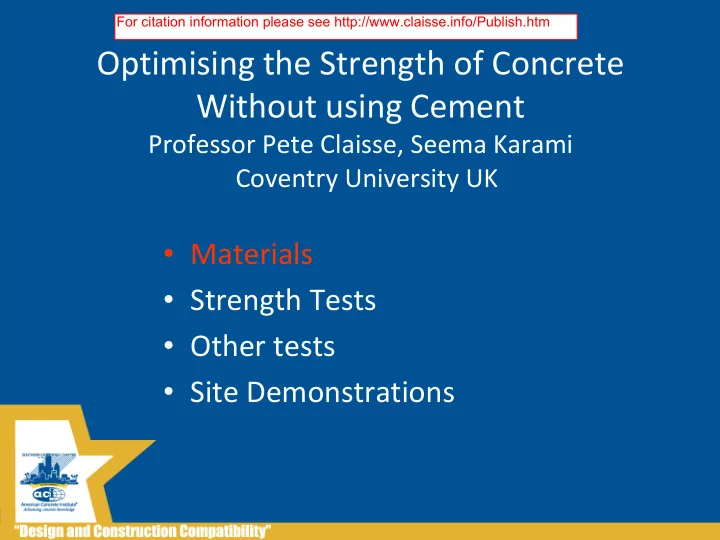

For citation information please see http://www.claisse.info/Publish.htm Optimising the Strength of Concrete Without using Cement Professor Pete Claisse, Seema Karami Coventry University UK • Materials • Strength Tests • Other tests • Site Demonstrations
Materials PG PG ROSA BPD Dried & Ground Passed #600 Dried & Dried & Ground Passed #600 Ground Passed #600 RG BOS BOS RG ROSA = Run of Station Ash (Coal fired power plant) BPD = By-pass dust (Cement works) PG = Plasterboard (wall board) gypsum BOS = Basic Oxygen Slag (Steel works) RG = Red Gypsum (Titanium dioxide pigment plant)
Optimising the Strength of Concrete Without using Cement Professor Pete Claisse Coventry University UK • Materials • Strength Tests • Other tests • Site Demonstrations
Laboratory Testing 2- Samples 1- Mix, 5 min 3- Crush Samples, 3, 7, and 28 days
Trial Mixes Step No.1: Optimization Of Binary RG Combinations RG RG PG PG BOS + , ROSA + , BPD + ROSA BPD PG BPD = 50 MIXES (300 samples) 0.3 liquid/solids in every mix ROSA = Run of Station Ash (Coal fired power plant) BPD = By-pass dust (Cement works) PG = Plasterboard (wall board) gypsum BOS = Basic Oxygen Slag (Steel works) RG = Red Gypsum (Titanium dioxide pigment plant)
BOS + ROSA +BPD Compressive strength MPa 100 90 90 28 DAY 7 DAY COMPRESSIVE 80 80 COMPRESSIVE STRENGTH STRENGTH 70 70 ROSA % ROSA % 60 60 50 50 50% BOS 40 40 35%ROSA 15%BPD 30 30 20 20 10 10 0 0 0 10 20 30 40 50 60 70 80 90 0 10 20 30 40 50 60 70 80 90 100 BOS % BOS % ROSA = Run of Station Ash (Coal fired power plant) BPD = By-pass dust (Cement works) PG = Plasterboard (wall board) gypsum BOS = Basic Oxygen Slag (Steel works) RG = Red Gypsum (Titanium dioxide pigment plant)
BOS + ROSA +RG Compressive strength MPa 80 60 70 50 7 DAY 7 DAY COMPRESSIVE 60 COMPRESSIVE STRENGTH STRENGTH 40 50 40 PG % 30 RG % 30 20 20 10 10 0 0 10 20 30 40 50 60 70 80 90 100 0 10 20 30 40 50 60 70 80 90 100 ROSA % ROSA % ROSA = Run of Station Ash (Coal fired power plant) BPD = By-pass dust (Cement works) PG = Plasterboard (wall board) gypsum BOS = Basic Oxygen Slag (Steel works) RG = Red Gypsum (Titanium dioxide pigment plant)
Mathematical Modelling Comparisons BOS 0.32 0.51 0 0.64 0 0.8 0 0.12 0 0.5 0.35 0 BPD 0.6 0.34 0.05 0.2 0.1 0.08 0.15 0.48 0.18 0 0 0.1 ROSA 0.08 0 0.855 0.16 0.81 0 0.765 0.4 0.72 0.45 0.45 0.81 PG 0 0.15 0 0 0 0.12 0 0 0 0 0 0.09 RG 0 0 0.095 0 0.09 0 0.085 0 0.1 0.05 0.2 0 Comp. Strength Mpa. 4.47 5.01 7.00 7.19 7.99 9.60 10.01 12.36 12.99 13.79 15.40 15.81 Error Comparison 100 90 Neural Network errors 80 response surface errors 70 ERRORS% 60 50 40 30 20 10 0 4.47 5.01 7.00 7.19 7.99 9.60 10.01 12.36 12.99 13.79 15.40 15.81 Compressive strength of Mixes(MPa)
The Optimised Mixture Designs 7 Day 28 Day Strength Strength Density BOS% ROSA% RG% PG% W/C MPa MPa Kg/m 3 48 40 12 0.2 2.6 17.5 2024 40 50 10 0.23 2.7 18.2 1912 40 50 10 0.2 2.0 19.4 1904 30 60 10 0.73 2.5 18.9 1820 30 60 10 0.47 2.38 18.6 1823 ROSA = Run of Station Ash (Coal fired power plant) BPD = By-pass dust (Cement works) PG = Plasterboard (wall board) gypsum BOS = Basic Oxygen Slag (Steel works) RG = Red Gypsum (Titanium dioxide pigment plant)
Optimising the Strength of Concrete Without using Cement Professor Pete Claisse Coventry University UK • Materials • Strength Tests • Other tests • Site Demonstrations
Sample Expansion BOS+BPD+PG+30%L/S BOS+ROSA+RG+27%L/S BOS+ROSA+RG+25%L/S
Other tests carried out or in progress Rheology – viscosity and yield point Freeze-thaw Permeability (picture below) Diffusion (picture below)
Optimising the Strength of Concrete Without using Cement Professor Pete Claisse Coventry University UK • Materials • Strength Tests • Other tests • Site Demonstrations
The mixture designs for the trials Trial Pour Cementitious component Strength MPa 1 Cell 1 top Spent borax 100% 4.5 2 Cell 2 top CKD 60%, Lagoon ash 40% 1.7 3 Cell 3 top CKD 60%, Lagoon ash 40% 1.3 1 Cell 1 base GGBS 90%,OPC 10%, 13 Sodium sulphate 2 Cell 2 base CKD 60%, PFA 40%, Sodium 6.9 sulphate 3 Cell 3 base OPC 5%, CKD, 70%, Lagoon 6 ash 25% 4 Trench fill BOS 60%, Red Gypsum 40% 1.8 5 Sub-base BOS 80%, PB 15%, BPD 5% 10.8 6 Base course BOS 80%, PB 15%, BPD 5% 30.55
Secondary materials in the mixes
Placing Trial 4.
The “Coventry Blend” • Basic oxygen slag from steel manufacture (80%) • Waste plasterboard (15%) • Kiln by-pass dust from cement manufacture.(5%) 100 Tonnes of this blend were made for trials 5 and 6 This blend is not recommended for partial replacement of cement – it is for use without cement
Trial 5 Car Park
Trial 6 Haul Road – Soil Stabilisation
Trial 6 Semi-Dry Paste/grout
Concrete without Cement (Trials 5 and 6) Concrete (trial 5) Semi-dry paste/grout (trial 6)
CONCLUSIONS 1 Viable mixtures which contain little or no • Portland cement can be made for a wide variety of applications. • Site trials represent the best route to develop these mixtures for commercial use. Pre-blended mixtures are the best way to • use powder which contains several mineral wastes.
Conclusions 2 • While it is possible to demonstrate the viability of cementitious mixtures which are sustainable there are many difficulties which may prevent their industrial use. These include: – Insurance problems – Lack of capital investment – Environmental concerns which may or may not have any scientific basis
Thank you For more information please visit www.claisse.info
Recommend
More recommend